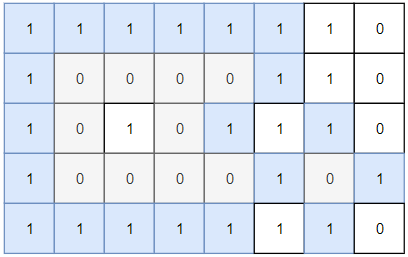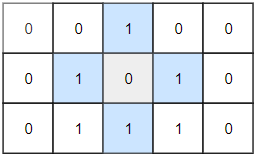Problem 1043. Partition Array for Maximum Sum
-
Given an integer array
arr, partition the array into (contiguous) subarrays of length at mostk. After partitioning, each subarray has their values changed to become the maximum value of that subarray. -
Return the largest sum of the given array after partitioning. Test cases are generated so that the answer fits in a 32-bit integer.
Examples
-
Example 1:
- Input: arr = [1,15,7,9,2,5,10], k = 3
- Output: 84
- Explanation: arr becomes [15,15,15,9,10,10,10]
-
Example 2:
- Input: arr = [1,4,1,5,7,3,6,1,9,9,3], k = 4
- Output: 83
-
Example 3:
- Input: arr = [1], k = 1
- Output: 1
Constraints:
1 <= arr.length <= 5000 <= arr[i] <= 10^91 <= k <= arr.length
Solution
- 다른 사람 풀이 참고 (Better indexing than the highest voted answer)
/**
* @param {number[]} arr
* @param {number} k
* @return {number}
*/
var maxSumAfterPartitioning = function(arr, k) {
const totalLength = arr.length;
const dp = new Array(totalLength + 1);
let sum = 0;
for (let i = 0; i <= totalLength; i++) {
dp[i] = sum;
sum += arr[i];
}
for (let i = 0; i <= totalLength; i++) {
let maxSum = 0;
for (let j = 1; j <= k && j <= i; j++) {
maxSum = Math.max(maxSum, arr[i - j]);
dp[i] = Math.max(dp[i], dp[i - j] + maxSum * j);
}
}
return dp[totalLength];
};Problem 1827. Minimum Operations to Make the Array Increasing
You are given an integer array nums (0-indexed). In one operation, you can choose an element of the array and increment it by 1.
For example, if nums = [1,2,3], you can choose to increment nums[1] to make nums = [1,3,3].
Return the minimum number of operations needed to make nums strictly increasing.
An array nums is strictly increasing if nums[i] < nums[i+1] for all 0 <= i < nums.length - 1. An array of length 1 is trivially strictly increasing.
Examples
-
Example 1:
- Input: nums = [1,1,1]
- Output: 3
- Explanation: You can do the following operations:
- Increment nums[2], so nums becomes [1,1,2].
- Increment nums[1], so nums becomes [1,2,2].
- Increment nums[2], so nums becomes [1,2,3].
-
Example 2:
- Input: nums = [1,5,2,4,1]
- Output: 14
-
Example 3:
- Input: nums = [8]
- Output: 0
Constraints:
1 <= nums.length <= 50001 <= nums[i] <= 10^4
Solution
/**
* @param {number[]} nums
* @return {number}
*/
var minOperations = function(nums) {
if (nums.length < 2) {
return 0;
}
let operationCount = 0;
for (let i = 1; i < nums.length; i++) {
if (nums[i] <= nums[i - 1]) {
const change = nums[i - 1] - nums[i] + 1;
operationCount += change;
nums[i] += change;
}
}
return operationCount;
};Problem 1254. Number of Closed Islands
-
Given a 2D
gridconsists of0s(land) and1s(water). An island is a maximal 4-directionally connected group of0sand a closed island is an island totally (all left, top, right, bottom) surrounded by1s. -
Return the number of closed islands.
Examples

- Example 1:
- Input: grid = [[1,1,1,1,1,1,1,0],[1,0,0,0,0,1,1,0],[1,0,1,0,1,1,1,0],[1,0,0,0,0,1,0,1],[1,1,1,1,1,1,1,0]]
- Output: 2
- Explanation:
- Islands in gray are closed because they are completely surrounded by water (group of 1s).

- Example 2:
- Input: grid = [[0,0,1,0,0],[0,1,0,1,0],[0,1,1,1,0]]
- Output: 1
Constraints
1 <= grid.length, grid[0].length <= 1000 <= grid[i][j] <=1
Solution
/**
* @param {number[][]} grid
* @return {number}
*/
var closedIsland = function(grid) {
const rowLength = grid.length;
const colLength = grid[0].length;
const directions = [[1, 0], [-1, 0], [0, 1], [0, -1]];
let closedIslandCount = 0;
const isOutsideGrid = (row, col) => {
return row < 0 || row >= rowLength || col < 0 || col >= colLength;
};
const isClosedIsland = (row, col) => {
const queue = [[row, col]];
let isClosed = true;
grid[row][col] = true;
while (queue.length) {
const [x, y] = queue.shift();
for (const [dx, dy] of directions) {
const nx = x + dx;
const ny = y + dy;
if (isOutsideGrid(nx, ny)) {
isClosed = false;
} else if (!grid[nx][ny]) {
grid[nx][ny] = true;
queue.push([nx, ny]);
}
}
}
return isClosed;
};
for (let row = 0; row < rowLength; row++) {
for (let col = 0; col < colLength; col++) {
if (!grid[row][col] && isClosedIsland(row, col)) {
closedIslandCount++;
}
}
}
return closedIslandCount;
};Problem 1525. Number of Good Ways to Split a String
-
You are given a string
s. -
A split is called good if you can split
sinto two non-empty stringssleftandsrightwhere their concatenation is equal tos(i.e.,sleft + sright = s) and the number of distinct letters insleftandsrightis the same. -
Return the number of good splits you can make in
s.
Examples
-
Example 1:
- Input: s = "aacaba"
- Output: 2
- Explanation: There are 5 ways to split "aacaba" and 2 of them are good.
- ("a", "acaba") Left string and right string contains 1 and 3 different letters respectively.
- ("aa", "caba") Left string and right string contains 1 and 3 different letters respectively.
- ("aac", "aba") Left string and right string contains 2 and 2 different letters respectively (good split).
- ("aaca", "ba") Left string and right string contains 2 and 2 different letters respectively (good split).
- ("aacab", "a") Left string and right string contains 3 and 1 different letters respectively.
-
Example 2:
- Input: s = "abcd"
- Output: 1
- Explanation: Split the string as follows ("ab", "cd").
Constraints
1 <= s.length <= 10*5sconsists of only lowercase English letters.
Solution
- 시간 초과된 풀이
/**
* @param {string} s
* @return {number}
*/
var numSplits = function(s) {
let goodSplitCount = 0;
for (let i = 1; i < s.length; i++) {
const leftSetSize = new Set(s.substring(0, i)).size;
const rightSetSize = new Set(s.substring(i)).size;
if (leftSetSize === rightSetSize) {
goodSplitCount++;
}
}
return goodSplitCount;
};- 2개의 Set과 1개의 array를 사용한 풀이
/**
* @param {string} s
* @return {number}
*/
var numSplits = function(s) {
const totalLength = s.length;
const leftSet = new Set();
const rightSet = new Set();
const leftSetSizes = [];
let goodSplitCount = 0;
for (let i = 0; i < totalLength; i++) {
leftSet.add(s[i]);
leftSetSizes[i] = leftSet.size;
}
for (let j = totalLength - 1; j > 0; j--) {
rightSet.add(s[j]);
if (leftSetSizes[j - 1] === rightSet.size) {
goodSplitCount++;
}
}
return goodSplitCount;
};